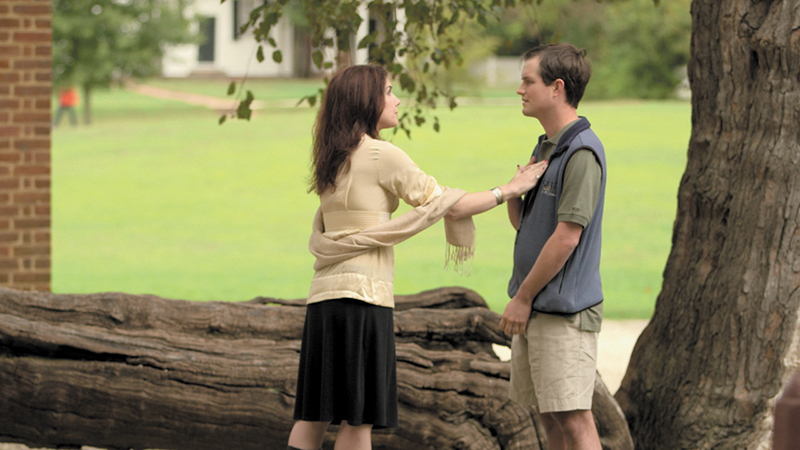
Autism in Love
Art
Back in 1988, Rain Man hit the theaters. Dustin Hoffman endeared audiences to one of his most memorable roles as mental calculator Raymond Babbitt, a character inspired by screenwriter Barry Morrow’s meeting with the real-life, Salt Lake City–born megasavant Kim Peek. The four-time Oscar Award–winning film launched Peek, along with his extraordinary memory capacity, to fame. With his father, Peek traveled the world, not only astonishing audiences with his abilities, but also inspiring them to recognize and respect each other’s differences.
After Peek’s passing in 2009, Morrow awarded Salt Lake City a statuette, inaugurating the Utah Film Center’s Peek Award for Disability in Film. “We worked with the city of Salt Lake to be able to do a celebration of how film might be used to honor disabilities,” says Elisabeth Nebeker, Executive Director of the Utah Film Center. “The Peek Award has been a way for us to spotlight the role of film in telling stories around disability, sharing with us individuals’ challenges, celebrating who they are and what they have to teach us, and radiating with acceptance.” Past winners have included the likes of Jason DaSilva, whose film When I Walk chronicles DaSilva’s experience after being diagnosed with multiple sclerosis, and actress Carrie Fisher, to honor her mental health advocacy and struggle with bipolar disorder.
Now in its fifth year, the 2016 Peek Award will honor director Matt Fuller and producer Carolina Groppa for their work on the poignant Autism in Love, which premiered as an official selection of the 2015 Tribeca Film Festival. Filmed cinéma-vérité style, the polished documentary offers sometimes heartrending, sometimes wrenching looks into three storylines about people on the autism spectrum as they grapple with various stages of romantic love. The young Lenny Felix is most forthright about his struggle to come to terms with his condition, which he feels has brought him nothing but isolation and rejection. The gentle Stephen Goodman rattles off Jeopardy! answers, rides the bus to his post office job and pays frequent visits to his wife, Geeta, who is sick with cancer. Then there are longtime partners Lindsey Nebeker and Dave Hamrick, who each describe the different ways by which they’ve learned to understand and express themselves to one another. “We wanted to make sure to represent the autism spectrum as fully as we could,” says Fuller. “Autism is complex, and we knew we couldn’t truly define it, but we wanted to be as wide and dynamic as we could in capturing how it affects people and their relationships differently.”
The documentary came to fruition when Dr. Ira Heilveil, who runs a practice in Southern California specifically for children on the spectrum, wanted to write a book or article about adults with autism and romance. Heilveil brought the concept to Groppa, who then worked as his research assistant. “The minute Ira pitched me the idea, I knew right away that it would make for a powerful documentary,” says Groppa, who enlisted Fuller’s help on the project. The pair began their research, interviewing individuals on the spectrum about their romantic lives and pursuits. Eventually, their research laid the foundation for the documentary and built a large network through which the two were able to find nine subjects—although, as is often the case with documentaries of this style, only four are shown in the final film. “We had full subjects that we spent a year with, that we got to know in a deep, meaningful way—so to make the decision to pull them out of the film is really, really difficult,” says Fuller, who accredits editor Alex O’Flinn. “Those decisions are always dictated by what’s best for the movie: How are we creating the most effective film? What’s going to keep audiences engaged, communicate what we want to communicate, affect them emotionally?”
Autism in Love is judicious and laudable, offering a shrewd and clear-eyed look into the lives of its characters. The narrative captures the subjects’ most vulnerable moments, some especially tender—like when each person describes their definitions of being in love, which range from mathematical formulas to looking into someone’s eyes to “I don’t know”—and some especially distressing. “We were never worried about exposing too much,” says Fuller, “because those moments were only brought up to the camera because our subjects wanted to share those with us, to be heard and understood in ways that they hadn’t before.”
Like so many other contemporary documentary films, Autism in Love is especially resonant and necessary because it offers an honest and accessible platform for underrepresented or inaccurately portrayed voices to share their stories on their own terms. “In Autism in Love, there’s a little bit of all of us in each of the subjects,” says Fuller. “That raw access to their minds and hearts makes you feel connected to them so deeply and so quickly. With the ability we have now to capture and tell stories, we can finally see ourselves onscreen in characters that are in other worlds than those that we live [in].”
The 2016 Peek Award for Disability in Film presentation and free film screening will be held Feb. 10 at 7 p.m. in the Rose Wagner Performing Arts Center. Director Matt Fuller, producer Carolina Groppa and film subjects David Hamrick and Lindsey Nebeker will be present for a post-film discussion moderated by RadioWest’s Doug Fabrizio. For more information about the film, visit autisminlove.com.
